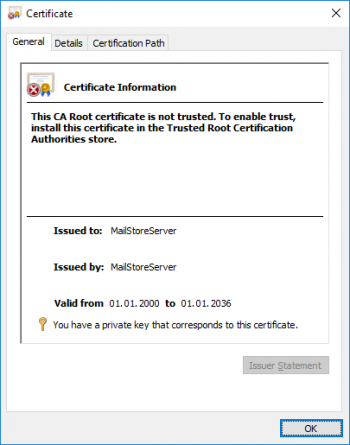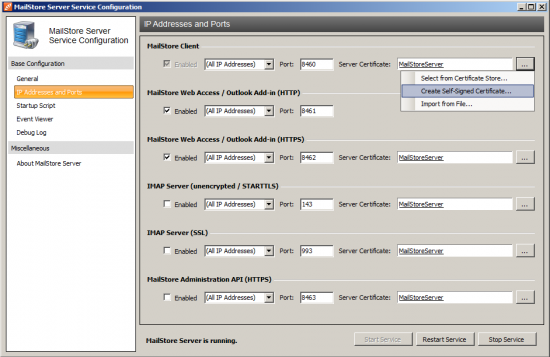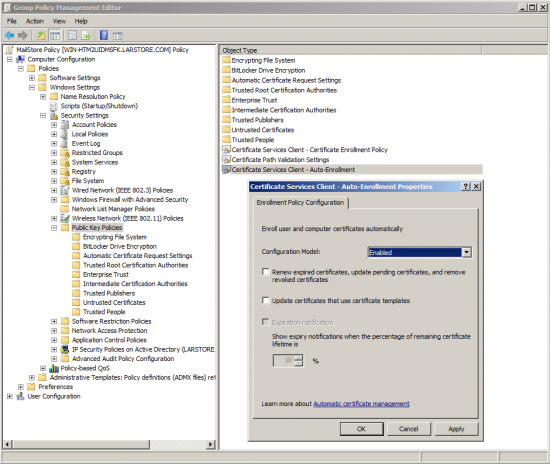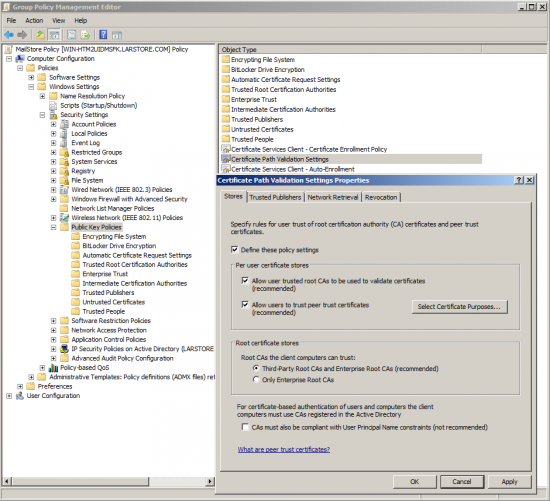Difference between revisions of "Deploying a Self-signed SSL Certificate"
| [unchecked revision] | [checked revision] |
Ltalaschus (talk | contribs) |
|||
| Line 3: | Line 3: | ||
== Background == | == Background == | ||
| − | During the installation of MailStore Server | + | During the installation of MailStore Server an SSL certificate is generated which is used by all MailStore components for encrypted connections. Because the certificate is issued with a server name ''MailStoreServer'' and does not originate from a trusted certification authority (CA), it is not trusted by the client side. |
[[File:MScert.png|350px|center]] | [[File:MScert.png|350px|center]] | ||
| − | Because of this, the following warning message appears when calling up MailStore Web Access via HTTPS (SSL) or when using the Outlook Add-In with the | + | Because of this, the following warning message appears when calling up MailStore Web Access via HTTPS (SSL) or when using the Outlook Add-In with the ''secure connection'' setting activated: |
[[File:MSnotrust.png|550px|center]] | [[File:MSnotrust.png|550px|center]] | ||
| − | When using a self-signed certificate the following requirements must be fulfilled so the client does not get a certificate warning. | + | When using a self-signed certificate, the following requirements must be fulfilled so the client does not get a certificate warning. |
* The hostname of the MailStore Server computer must be in in the ''Subject'' or ''Subject Alternative Name'' field of the certificate. | * The hostname of the MailStore Server computer must be in in the ''Subject'' or ''Subject Alternative Name'' field of the certificate. | ||
| Line 18: | Line 18: | ||
* The certificate must not be expired. | * The certificate must not be expired. | ||
| − | This article describes the option to deploy self-signed certificates using a group policy. An alternative is to use officially signed SSL certificates issued by your own company CA or a trusted external certificate authority, such as VeriSign or eTrust | + | This article describes the option to deploy self-signed certificates using a group policy. An alternative is to use officially signed SSL certificates issued by your own company CA or a trusted external certificate authority, such as VeriSign or eTrust. This is described in chapter [[Using Your Own SSL Certificate]]. |
| − | To configure MailStore Server and your clients for using a self-signed certificate, please proceed as | + | To configure MailStore Server and your clients for using a self-signed certificate, please proceed as follows: |
== Preparing a Self-Signed Certificate == | == Preparing a Self-Signed Certificate == | ||
| Line 28: | Line 28: | ||
The certificate created during the installation is issued to ''MailStoreServer''. | The certificate created during the installation is issued to ''MailStoreServer''. | ||
| − | Therefore an A- or CNAME-record ''MailStoreServer'' must be present | + | Therefore an A- or CNAME-record ''MailStoreServer'' must be present on the DNS server that can be used to reach the MailStore Server computer. |
=== Alternative 2: Create a certificate by using the MailStore Server Service Configuration === | === Alternative 2: Create a certificate by using the MailStore Server Service Configuration === | ||
| − | This alternative should be preferred | + | This alternative should be preferred when you want to use a new certificate with default parameters. These parameters are basically: |
* The ''Subject'' field is user defined. This equates to the hostname of the MailStore Server computer. | * The ''Subject'' field is user defined. This equates to the hostname of the MailStore Server computer. | ||
| Line 40: | Line 40: | ||
* The ''FriendlyName'' value is not set. | * The ''FriendlyName'' value is not set. | ||
| − | To create the certificate proceed as follows: | + | To create the certificate, proceed as follows: |
* Open the MailStore Server Service Configuration. | * Open the MailStore Server Service Configuration. | ||
| Line 46: | Line 46: | ||
* Click on the button next to the field ''Server Certificate'' and select ''Create Self-Signed Certificate...'' | * Click on the button next to the field ''Server Certificate'' and select ''Create Self-Signed Certificate...'' | ||
*: [[File:Deploy_selfsigned_00.png|center|550px]] | *: [[File:Deploy_selfsigned_00.png|center|550px]] | ||
| − | * As name for the new certificate | + | * As name for the new certificate enter the server name of the MailStore Server machine, e.g. mailstore.mydomain.local, and click on ''OK''. |
* If necessary, replace all additional server certificates with the new certificate. To do so, click on the button next to the ''Server Certificate'' field and select ''Select from Certificate Store...'' | * If necessary, replace all additional server certificates with the new certificate. To do so, click on the button next to the ''Server Certificate'' field and select ''Select from Certificate Store...'' | ||
=== Alternative 3: Create a certificate by using certreq === | === Alternative 3: Create a certificate by using certreq === | ||
| − | This alternative should be preferred | + | This alternative should be preferred if the certificate has to conform to requirements that cannot be fulfilled with the default parameters. For example, if you want to use ''Subject Alternative Names'' or if you want a limited validity period. |
* Log on to the MailStore Server computer. | * Log on to the MailStore Server computer. | ||
| Line 89: | Line 89: | ||
certreq -new request.inf request.csr | certreq -new request.inf request.csr | ||
* Open the MailStore Server Service Configuration. | * Open the MailStore Server Service Configuration. | ||
| − | * Click on ''IP- | + | * Click on ''IP-Adresses and Ports''. |
* Click on the button next to the field ''Server Certificate'' (…) and select ''Select from Certificate Store...'' | * Click on the button next to the field ''Server Certificate'' (…) and select ''Select from Certificate Store...'' | ||
* Select the previously created certificate and press ''OK''. | * Select the previously created certificate and press ''OK''. | ||
| Line 109: | Line 109: | ||
== Deploying a Self-Signed Certificate == | == Deploying a Self-Signed Certificate == | ||
| − | Before the self-signed certificate can be deployed | + | Before the self-signed certificate can be deployed it must be exported from the current certificate store. Please proceed as follows: |
* Open the MailStore Server Service Configuration. | * Open the MailStore Server Service Configuration. | ||
| − | * Click on ''IP- | + | * Click on ''IP-Adresses and Ports''. |
* Click on the certificate. | * Click on the certificate. | ||
* Open the ''Details'' tab. | * Open the ''Details'' tab. | ||
* Click on ''Copy to File''. | * Click on ''Copy to File''. | ||
| − | * Follow the instructions of the certificate export wizard to export the certificate ''without'' the private key in DER encoded format into a file. | + | * Follow the instructions of the certificate export wizard to export the certificate '''without''' the private key in DER encoded format into a file. |
| − | Once the certificate has been exported to a file, create a group policy as described in chapters [[MailStore Client Deployment]] or [[MailStore Outlook Add-in Deployment]] | + | Once the certificate has been exported to a file, create a group policy as described in chapters [[MailStore Client Deployment]] or [[MailStore Outlook Add-in Deployment]]. To deploy the certificate customize the GPO as follows: |
* Open the group policy object using the ''Group Policy Management Editor'' of your Windows server. | * Open the group policy object using the ''Group Policy Management Editor'' of your Windows server. | ||
* Expand the ''Computer Configuration'' > ''Policies'' > ''Windows Settings'' > ''Security Settings'' > ''Public Key Policies''. | * Expand the ''Computer Configuration'' > ''Policies'' > ''Windows Settings'' > ''Security Settings'' > ''Public Key Policies''. | ||
| − | * Right-click on ''Trusted Root Certification Authorities'' and select ''Import...'' | + | * Right-click on ''Trusted Root Certification Authorities'' and select ''Import...'' |
* Follow the instructions of the certificate import wizard to import the certificate from the file. | * Follow the instructions of the certificate import wizard to import the certificate from the file. | ||
| − | * Under ''Public Key Policies'' open the properties of the ''Certificate Services Client - Auto-Enrollment'' | + | * Under ''Public Key Policies'' open the properties of the ''Certificate Services Client - Auto-Enrollment''. |
*: [[File:Deploy_selfsigned_01.png|center|550px]] | *: [[File:Deploy_selfsigned_01.png|center|550px]] | ||
* Change the ''Configuration Model'' to ''Enabled'' and click on ''OK''. | * Change the ''Configuration Model'' to ''Enabled'' and click on ''OK''. | ||
Revision as of 10:15, 3 March 2016
Background
During the installation of MailStore Server an SSL certificate is generated which is used by all MailStore components for encrypted connections. Because the certificate is issued with a server name MailStoreServer and does not originate from a trusted certification authority (CA), it is not trusted by the client side.
Because of this, the following warning message appears when calling up MailStore Web Access via HTTPS (SSL) or when using the Outlook Add-In with the secure connection setting activated:
When using a self-signed certificate, the following requirements must be fulfilled so the client does not get a certificate warning.
- The hostname of the MailStore Server computer must be in in the Subject or Subject Alternative Name field of the certificate.
- The client must use one of these names when connecting to MailStore Server.
- The issuer of the certificate must be trusted.
- The certificate must not be expired.
This article describes the option to deploy self-signed certificates using a group policy. An alternative is to use officially signed SSL certificates issued by your own company CA or a trusted external certificate authority, such as VeriSign or eTrust. This is described in chapter Using Your Own SSL Certificate.
To configure MailStore Server and your clients for using a self-signed certificate, please proceed as follows:
Preparing a Self-Signed Certificate
Alternative 1: Using the automatically generated certificate
The certificate created during the installation is issued to MailStoreServer.
Therefore an A- or CNAME-record MailStoreServer must be present on the DNS server that can be used to reach the MailStore Server computer.
Alternative 2: Create a certificate by using the MailStore Server Service Configuration
This alternative should be preferred when you want to use a new certificate with default parameters. These parameters are basically:
- The Subject field is user defined. This equates to the hostname of the MailStore Server computer.
- The certificate is valid until 1/1/2036.
- The signature algorithm is SHA1.
- Subject Alternative Names are not set.
- The FriendlyName value is not set.
To create the certificate, proceed as follows:
- Open the MailStore Server Service Configuration.
- Click on IP Addresses and Ports.
- Click on the button next to the field Server Certificate and select Create Self-Signed Certificate...
- As name for the new certificate enter the server name of the MailStore Server machine, e.g. mailstore.mydomain.local, and click on OK.
- If necessary, replace all additional server certificates with the new certificate. To do so, click on the button next to the Server Certificate field and select Select from Certificate Store...
Alternative 3: Create a certificate by using certreq
This alternative should be preferred if the certificate has to conform to requirements that cannot be fulfilled with the default parameters. For example, if you want to use Subject Alternative Names or if you want a limited validity period.
- Log on to the MailStore Server computer.
- Prepare a text file request.inf with the following content:
;----------------- request.inf ----------------- [Version] Signature="$Windows NT$" [NewRequest] ; replace Subject attributes in the line below with real values Subject = "CN=mailstoreserver.example.com, OU=Department, O=Organisation, L=Locality, S=State, C=Country" HashAlgorithm = sha1 KeySpec = 1 KeyLength = 2048 Exportable = TRUE FriendlyName = mailstoreserver.example.com MachineKeySet = TRUE SMIME = False PrivateKeyArchive = FALSE UserProtected = FALSE UseExistingKeySet = FALSE ProviderName = "Microsoft RSA SChannel Cryptographic Provider" ProviderType = 12 RequestType = Cert KeyUsage = 0xa0 NotBefore = "1/1/2016 00:00 AM" NotAfter = "12/31/2019 11:59 PM" [EnhancedKeyUsageExtension] OID = 1.3.6.1.5.5.7.3.1 ; this is for Server Authentication
- Adjust Subject, FriendlyName, NotBefore and NotAfter according to your needs.
- Save the file.
- Open an elevated command prompt and navigate to the directory where the request.inf is stored.
- Create the certificate by executing the following command:
certreq -new request.inf request.csr
- Open the MailStore Server Service Configuration.
- Click on IP-Adresses and Ports.
- Click on the button next to the field Server Certificate (…) and select Select from Certificate Store...
- Select the previously created certificate and press OK.
- Replace the other certificates by clicking on the button next to the field Server Certificate (…) and select Select from Certificate Store...
Optional: Subject Alternative Names (SAN)
If the certificate should be valid for multiple host names, so called Subject Alternative Named (SAN) must be included. Add the Extensions section as shown below to the the end of the request.inf file and adjust the host names to your needs or add additional ones by appending additional _continue_ lines. Then save the file and create the certificate as explained previously.
[Extensions]
2.5.29.17 = "{text}"
_continue_ = "DNS=mailstoreserver.example.com&"
_continue_ = "DNS=mailstoreserver&"
_continue_ = "IPADDRESS=172.31.1.5&"
Important notice: When SANs are defined, the CN in the Subject field will be ignored by clients. Therefore all valid host names have to be added to the SAN extension.
Deploying a Self-Signed Certificate
Before the self-signed certificate can be deployed it must be exported from the current certificate store. Please proceed as follows:
- Open the MailStore Server Service Configuration.
- Click on IP-Adresses and Ports.
- Click on the certificate.
- Open the Details tab.
- Click on Copy to File.
- Follow the instructions of the certificate export wizard to export the certificate without the private key in DER encoded format into a file.
Once the certificate has been exported to a file, create a group policy as described in chapters MailStore Client Deployment or MailStore Outlook Add-in Deployment. To deploy the certificate customize the GPO as follows:
- Open the group policy object using the Group Policy Management Editor of your Windows server.
- Expand the Computer Configuration > Policies > Windows Settings > Security Settings > Public Key Policies.
- Right-click on Trusted Root Certification Authorities and select Import...
- Follow the instructions of the certificate import wizard to import the certificate from the file.
- Under Public Key Policies open the properties of the Certificate Services Client - Auto-Enrollment.
- Change the Configuration Model to Enabled and click on OK.
- Under Public Key Policies open the properties of the Certificate Path Validation Settings.
- Place a checkmark next to Define these policy settings and click OK.
The group policy will be enabled once the workstation is restarted.





